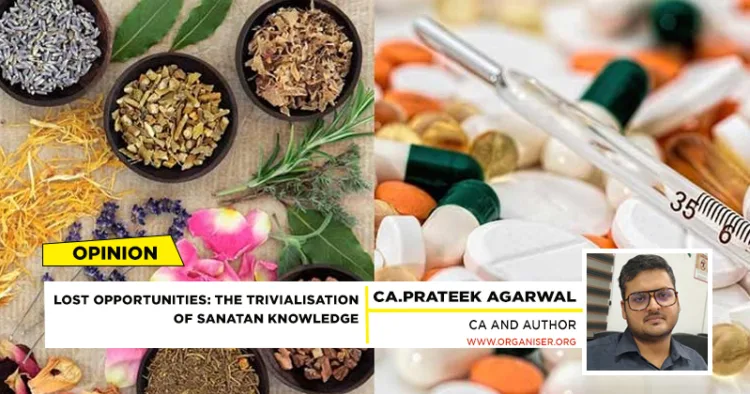In a world increasingly focused on modernity, the rich heritage of Sanatan knowledge—including systems like Ayurveda—has often been overlooked. With the global pharmaceutical market valued at a staggering 1.6 trillion dollars, it’s disheartening to note that the Ayurvedic market constitutes only 2 per cent of this total, despite Ayurveda being one of the world’s oldest and most comprehensive systems of medicine. This disparity highlights a broader issue: the trivialisation of Sanatan traditions and the economic opportunities that have been missed as a result.
A Rich Heritage Ignored
Sanatan knowledge encompasses not just Ayurveda but also various traditional practices in agriculture, education, and sustainable living, offering immense potential. Ancient texts such as the Charaka Samhita, Sushruta Samhita, and Ashtanga Hridaya provide a wealth of information, detailing over 700 herbs and more than 6,000 formulations for various health conditions. The Madhav Nidan, a classic from around 800 AD, offers insights into over 5,000 signs and symptoms, further emphasising the depth and complexity of this traditional knowledge.
Despite this rich heritage, these systems have often been marginalised in favour of Western medical paradigms. Since India’s independence, there has been a persistent failure to acknowledge the significance of traditional knowledge systems. The post-colonial leadership seemed more inclined to adopt modern medical practices, often dismissing indigenous methods as archaic or irrelevant. This choice has not only sidelined valuable wisdom but also resulted in significant economic losses for the country.
If India had invested in the research and development of Ayurveda after independence, it could have secured a major share of medicinal patents and a substantial portion of the global medicinal market, which is currently dominated by the USA (44 per cent), followed by China and the EU.
Recognition and Progress
In a pivotal move, the Indian Government first recognised the vast potential of traditional medicine in November 2014, transforming the erstwhile department into a dedicated ministry: the Ministry of AYUSH (Ayurveda, Yoga, Naturopathy, Unani, Siddha, and Homeopathy). This change allowed for a separate budget for research, pulling these traditional practices out of the shadows of modern medicine.
Since then, the Ministry of AYUSH has signed 24 country-to-country memoranda of understanding (MoUs) for cooperation in the field of traditional medicine and homoeopathy with nations like China, Germany, Japan, Iran, Brazil, Bangladesh, and Malaysia. Additionally, 43 MoUs for collaborative research and academic collaboration have been signed with foreign institutes and universities, paving the way for greater integration of traditional knowledge into global practices.
Notably, in 2022, KAL obtained its first patent from the US and met California’s Prop 65 standards, one of the most stringent requirements for drugs, for its herbal drug targeting Type-2 diabetes, obesity, and lipid profile management. Furthermore, in 2024, Indian patents for an Ayurvedic formulation developed by BHU, Varanasi, that demonstrates 95 per cent efficacy against the SARA virus were granted.
The Patent Landscape
The landscape of patent filings reflects a renewed interest in Ayurveda. From independence until March 31, 2013, a total of 609 patents were filed by Indian entities in the field of Ayurveda, with only 119 granted. In stark contrast, during just three years of the Modi Government (2019-2021), 761 patents were filed, with 86 granted. This significant increase underscores the untapped potential of traditional knowledge systems in the modern marketplace.
Broader Opportunities
The missed opportunities in Ayurveda are just the tip of the iceberg. Numerous traditional knowledge systems remain underexplored, offering great economic value not only to India but to the world. Areas such as organic agriculture, the use of natural fertilisers, the benefits of millets, ancient educational models (Nalanda, Takshashila, Vikramashila), indigenous liquors like Mahua, metallurgy (like the Iron Pillar from Chandragupta’s era), sustainable architecture, wellness health, and beauty care are all ripe for exploration and innovation.
A Call for Change
The reasons for this oversight are complex. One might point to the legacy of leaders like the Nehru family, who shaped the vision of post-independence India with a socialist mindset that often overlooked ancient Indian principles. The influence of Thomas Babington Macaulay’s education policy in 1835, which prioritised Western education over indigenous systems, created a divide that continues to affect perceptions of traditional knowledge. Macaulay’s in some sense succeeded in creating a class which are Indian in blood and colour, but English in taste, in opinions, in morals, and in intellect”.
As we move forward, there is a pressing need for a drastic change in mindset across the political landscape. Recognising and valuing the Traditional Knowledge System of Sanatan, free from the constraints of minority appeasement and pseudo-secularism, is essential. Acknowledging the financial forces of the Western world should not deter India from reclaiming its heritage and capitalising on the wealth of knowledge it possesses.
The trivialisation of Sanatan knowledge systems represents not just a cultural oversight but also a significant economic opportunity that has been squandered. By recognising and investing in these traditions, India can not only reclaim its heritage but also position itself as a leader in the global wellness economy. The path forward lies in acknowledging the value of this knowledge, investing in its potential, and ensuring that it plays a pivotal role in shaping a sustainable and prosperous future for all.



















Comments